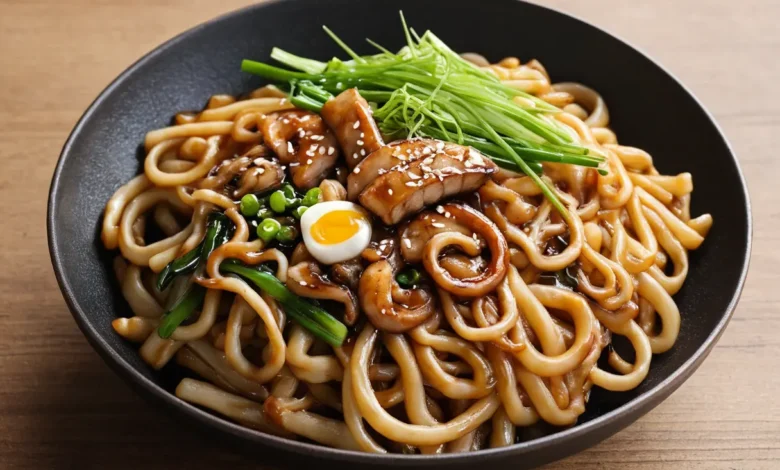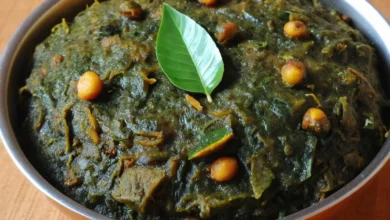How to Make Delicious Yaki Udon: A Simple Guide to Savory Japanese Stir-Fried Noodles

Yaki Udon is a popular Japanese stir-fried noodle dish, celebrated for its rich, savory flavors and chewy texture. Made with thick udon noodles, vegetables, and a flavorful sauce, Yaki Udon is quick to prepare, making it a favorite for weeknight dinners or when you’re craving comfort food. In this guide, we’ll dive into a classic Yaki Udon recipe and answer common questions to help you create a mouthwatering meal right at home.
What is Yaki Udon?
Yaki Udon, meaning “fried udon,” is a Japanese dish made by stir-frying udon noodles with vegetables, meat, or seafood, all coated in a savory soy-based sauce. Originating from Japan’s Fukuoka region, Yaki Udon is easy to customize, making it versatile enough to cater to different tastes. Traditionally made with beef, pork, or chicken, you can also enjoy a vegetarian or seafood version by adjusting the ingredients to your preference.
Recipe for Classic Yaki Udon
Ingredients
- Udon Noodles: 2 servings (fresh, frozen, or dried; if using dried, follow package instructions for boiling)
- Protein: 100g thinly sliced beef, chicken, pork, or tofu
- Vegetables: 1/2 cup shredded cabbage, 1/4 cup sliced carrots, 1/4 cup sliced onions, 1/4 cup sliced bell pepper, 2-3 shiitake mushrooms (optional)
- Garlic: 1 clove, minced
- Garnish: Green onions, sesame seeds, and pickled ginger (optional)
Yaki Udon Sauce
- 2 tbsp soy sauce
- 1 tbsp oyster sauce (or hoisin sauce for a vegetarian option)
- 1 tbsp mirin or rice vinegar
- 1/2 tbsp sesame oil
- 1/2 tbsp sugar
Instructions
- Prepare the Noodles: If using fresh or frozen udon noodles, blanch them briefly in boiling water until soft and drain. If using dried noodles, cook as per package instructions and set aside.
- Make the Sauce: In a bowl, whisk together soy sauce, oyster sauce, mirin, sesame oil, and sugar until well combined.
- Cook the Protein: Heat a large skillet or wok over medium-high heat. Add a little oil and cook the sliced meat or tofu until browned, about 3-4 minutes. Remove from the pan and set aside.
- Stir-Fry the Vegetables: In the same pan, add a bit more oil if needed and sauté garlic until fragrant. Add the sliced vegetables and stir-fry for 3-5 minutes until slightly softened but still crisp.
- Combine and Toss: Return the cooked protein to the pan, add the noodles, and pour in the sauce. Toss everything together until the noodles are evenly coated and heated through.
- Garnish and Serve: Top with chopped green onions, sesame seeds, and pickled ginger if desired. Serve hot and enjoy your homemade Yaki Udon!
Frequently Asked Questions About Yaki Udon
- What type of noodles should I use for Yaki Udon?
Fresh or frozen udon noodles are the best options as they provide a chewy texture and absorb the sauce well. If you only have dried udon noodles, simply boil them as per the package directions before adding them to the dish. - Can I make Yaki Udon vegetarian or vegan?
Absolutely! Replace the meat with tofu or your favorite plant-based protein, and swap the oyster sauce with hoisin sauce or soy sauce for a vegan-friendly version. - What vegetables work well in Yaki Udon?
Cabbage, carrots, onions, and bell peppers are popular choices, but you can also add mushrooms, spinach, zucchini, or snap peas for added texture and flavor. - Can I use other sauces in place of the Yaki Udon sauce?
While the traditional sauce mix includes soy sauce and oyster sauce, feel free to experiment with teriyaki sauce, a hint of miso paste, or even a dash of sriracha for a spicy twist. - How can I keep my Yaki Udon noodles from sticking?
To prevent sticking, rinse the noodles after cooking, especially if using dried udon. Adding a little sesame oil to the noodles before stir-frying can also help keep them separated. - Is Yaki Udon similar to Yaki Soba?
While both are Japanese stir-fried noodle dishes, Yaki Soba uses thin wheat noodles, whereas Yaki Udon uses thick, chewy udon noodles. The sauces also vary slightly, with Yaki Udon leaning towards a more soy-based flavor profile.
Tips for Making Perfect Yaki Udon
- Use High Heat: Stir-frying at high heat helps achieve a slight char on the noodles and vegetables, adding a hint of smokiness to the dish.
- Keep Ingredients Crisp: Avoid overcooking the vegetables so they retain their crunch. Add them in stages, starting with the denser veggies like carrots and cabbage.
- Customize the Protein: Yaki Udon is great with beef, pork, chicken, shrimp, or tofu. You can even mix two types for added texture and flavor.
- Try Different Toppings: Experiment with different garnishes, such as a sprinkle of furikake (Japanese seasoning), shichimi togarashi (spicy pepper mix), or a drizzle of kewpie mayo for extra flavor.
Conclusion
Yaki Udon is a delicious and versatile dish that’s perfect for any occasion, from a quick lunch to a satisfying dinner. The combination of thick, chewy noodles, savory sauce, and colorful veggies makes it a well-balanced meal that’s easy to prepare. Whether you prefer a classic version or a customized twist with unique ingredients, Yaki Udon is sure to become a favorite in your meal rotation. So next time you’re craving Japanese cuisine, whip up a bowl of Yaki Udon and savor the flavors of Japan in your own kitchen!





